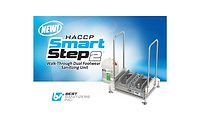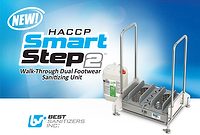HACCP Canada-Style: New Rules Advance Best Practices

North American regulatory bodies, including the U.S. Department of Agriculture’s Food Safety Inspection Service (USDA FSIS), the U.S. Food and Drug Administration (FDA) and the Canadian Food Inspection Agency (CFIA), have long shared common ground in both mandating and encouraging voluntary implementation of Hazard Analysis Critical Control Points (HACCP) programs in food processing and handling operations. Indeed, the HACCP model of science-based food hazard prevention and process control is among the most recognized food safety management tools in the world, an integral part of many national regulatory systems that reach well beyond the U.S.-Canadian border.
Until recently, however, U.S.-Canadian regulatory common ground in terms of mandatory HACCP wholly intersected only in the fish and seafood processing sector, an industry required to implement HACCP in both countries. Unlike its southern neighbor, Canada had not mandated the use of HACCP in all of the country’s meat and poultry operations. Only Canadian slaughtering operations exporting to the U.S. have been required to implement a HACCP program in order to maintain access to the American market.
In December 2004, CFIA published proposed amendments to Canada’s federal Meat Inspection Regulations, 1990, which require the implementation of a mandatory Food Safety Enhancement Program (FSEP) in all federally registered meat and poultry establishments and storage facilities. The FSEP is CFIA’s approach to encourage and support the development and implementation of HACCP systems in all federally registered establishments in the meat, dairy, honey, maple syrup, processed fruit and vegetable, shell egg, processed egg and poultry hatchery sectors. Along with the proposed amendments, CFIA mandated that all meat and poultry establishments operating within Canada must be “HACCP-recognized” by November 2005, and that such recognition will involve a registration and licensing requirement—in other words, no HACCP, no federal registration or license.
While CFIA does recognize that the Canadian food industry has been gradually implementing FSEP on a voluntary basis since its establishment in the early 1990s, with the meat industry leading the way, the agency has made clear that the main reason for implementing mandatory FSEP for all establishments in the federally regulated meat sector is to enhance the safety of meat products both produced in and imported into Canada. According to CFIA, as of December 2004, 86% of Canada’s federally-registered meat and poultry establishments were or were in the process of becoming FSEP-recognized.
The proposed amendments to introduce mandatory FSEP (i.e., HACCP) in all federally registered meat and poultry establishments and registered storages are currently under review by CFIA and industry stakeholders, including many prominent national meat organizations. CFIA issued the following list of reasons to the industry as to why the amendments should be made:
• When properly designed and implemented, the science-based HACCP system significantly reduces the risk of biological, physical or chemical hazards reaching the consumer. HACCP ensures that all aspects of an operation are analyzed on a continuous basis allowing for improvements in plant efficiencies, such as fewer product recalls.
• HACCP systems are recognized under Codex Alimentarius as an internationally accepted standard for food safety. The U.S. already requires that imported meat and poultry be produced under HACCP in the country of origin. Other countries, including Australia and Japan have mandatory HACCP systems. Canada’s continued access to foreign markets could depend on the ability of industry to demonstrate adherence to a HACCP system.
• By setting out clear roles and responsibilities for industry and government in meat inspection activities, HACCP encourages shared responsibility for food safety leading to greater efficiency and effectiveness in the inspection process. CFIA inspectors are able to focus more on critical food safety areas in the production process while trained industry employees assume more responsibility for detecting and removing food safety hazards.
• Mandatory FSEP provides the CFIA with the opportunity to adapt its meat inspection program to make it more effective. Inspection staff are given a broader scope for compliance and enforcement activities focusing on the verification of the effectiveness of HACCP systems and ensuring conformance with all applicable regulations in these establishments.
Under FSEP, the food establishment’s HACCP system must meet all current program requirements, such as conducting a hazard analysis and identifying critical control points (CCPs), tailored to each food processing plant’s specific products and processes. The HACCP system also must include the implementation of six prerequisite programs—basic requirements for the premises, transportation and storage, equipment maintenance and calibration, sanitation and pest control, personnel, and recall procedures—as well as the relevant HACCP plans for that establishment. CFIA verifies that a company’s HACCP system is implemented according to the written procedures and is effective in providing the required control measures.
Again, no processing plant can be CFIA HACCP recognized until its HACCP system has been fully evaluated in accordance with CFIA’s FSEP guidelines. The new HACCP registration and licensing requirement for federally inspected meat processing operations means that these establishments will need to ensure that their HACCP plans meet the benchmark for best practices in order to continue doing business.
Universal Tips for HACCP
With less than a year to obtain CFIA “HACCP Recognized” status, Canada-based meat and poultry establishments are ratcheting up their efforts to meet the new registration and licensing requirement. While the majority of these processing operations have or are in the process of HACCP implementation, some small- and mid-sized companies—particularly those that do not export to the U.S. and as such, are under no pressure to implement a HACCP program for in-country trade—now find themselves scrambling to develop their plans to attain HACCP recognition by the deadline to maintain their market.
Meanwhile, although HACCP is recognized as a powerful food safety tool, food producers, processors and distributors continue to voice legitimate concerns while developing and implementing HACCP plans. Certain issues appear to be universally problematic, and each of these challenges will need to be addressed and resolved before the HACCP plan can be completed. Here are a few tips that can help:
Hazard Identification. Hazard identification is the HACCP principle step in which the developer systematically reviews all processes, procedures and ingredients to compile a list of hazards associated with these ingredients and/or activities. The completion of this task can produce enormous lists of hazard after hazard, leaving the developer feeling confused and overwhelmed by the magnitude and volume of hazards to be addressed and controlled. Historically, this principle of HACCP development has been a point of contention between plan developers and auditors or regulatory bodies because the principle itself is often obscured by the sheer amount of information generated. The key to managing and getting control over the hazard identification step is to identify only those hazards most likely to occur.
When developing your list of hazards, you must identify first what hazards are possible, and then consider which of those are probable. Identifying only those that are probable hazards for your operation gives the list credibility and results in a more manageable program. “Possibility” encompasses every little detail and hazard that might occur in your operation. The result of brainstorming every possibility is a seemingly endless list of hazards, the majority of which are likely not probable. “Prob-ability” satisfies the requirement of identifying hazards that are most likely to occur. For example, I could venture outside and be hit by a bus and a meteor, win the lottery and solve world hunger all at the exact same millisecond in time. Is this possible? Yes, anything is possible. Is this probable? No, the odds aren’t very good that I could achieve all this at the same point in time, if ever.
When performing a hazard analysis, ask yourself and your team: Is this hazard possible? If the answer is yes, then ask the second question: Is this hazard probable? If yes, then first address the hazard in your prerequisite program. If there is not a logical prerequisite item to address the hazard then incorporate the hazard into your HACCP plan. If the answer to possibility is no, support your decision with rationale and move on to the next possible hazard. For example, in a meat processing environment an identified legitimate physical hazard might be hazardous extraneous material in the form of wooden splinters. Is it possible that wooden splinters may contaminate the product? Yes, it is possible because anything is possible. Is it probable that wooden splinters may contaminate the product? No, I have no wooden material anywhere in my plant that could generate wooden splinters. In this case, you would carry on to the next identified hazard, eliminating extra time, steps and money to manage a hazard that is not probable.
Scrutiny/Confidence Issues. Once you have mastered the art of providing rationale for the decisions made while developing and implementing your HACCP plan, you will now be able to stand behind that plan, which is extremely important when it comes under scrutiny. For each prerequisite item, CCP and other considerations, ensure that regulatory or industry references are filed with the prerequisite item or CCP by using page protectors to keep each item’s information together but separate from other items. Having your plan assembled in this manner allows for quick information management during an audit, and also serves as a reminder and a defense as to how the decision was made. This leaves no room for interpretation by either plant representatives or auditors because all of the pertinent information is readily at hand.
Auditors are trained to ask “open-ended” questions which elicit more than a “yes” or “no” response. Depending on the response from plant representatives, an auditor can gain valuable information that may lead him or her to areas of perceived uncertainty that could be fatal to the audit. Even though the program is in place, functional and adequate, if the auditor senses uncertainty or doubtfulness from the plant representative in relation to the written program, the auditor will also feel uncertain and doubtful about the program. If clearly developed rationale is provided in detail supporting the plan, it enables the plant representative to stand firmly behind and defend the written plan. Remember that your plan is specific to you, your employees and your operation—therefore, rationalizing, defending and standing behind your plan is essential.
Disasters During Audit. During a HACCP audit, unexpected disasters can happen: It may be raining in your cold storage facility, or a product line has backed up and a mountain of product is falling to the floor. Most plant representatives internalize these disasters with doom and gloom, thinking they have just failed the audit. The key to surviving the disaster during an audit is to stand behind your plan and deal with the disaster immediately, effectively and completely. Instead of viewing a disaster as a dreadful, fatal event, view it as your team’s time to shine. Let your auditor see you in action, rising to the occasion, competently and effectively dealing with the incident. This will show your auditor that you are confident and comfortable with your plan, and that you can deal with the crisis as written in your plan. Plans are developed for two main reasons. The first is to proactively prevent disasters but the second is to deal with disasters should they occur.
During plan development, write what you do, do what you write and prove it. Using this mantra will guarantee success during a disaster. In addition, keep control of your audit and auditor at all times. Never let your auditor have the opportunity to deal with the crisis for you, as this will ensure a negative outcome. Instead, calmly ask your auditor to wait while the event is managed and put your plan into action. Never leave your auditor alone while you deal with an incident. Auditors left alone will wander and possibly stumble upon other situations requiring attention, except this time there isn’t a plant representative available to correct the situation. Always have a designated plant representative to shadow the auditor at all times so other team members can deal with catastrophes, should they occur, and your auditor isn’t left to explore unaccompanied.
Managing the Cost of HACCP. One of the biggest hurdles to overcome for small- to medium-sized establishments when developing and implementing a plan is cost. Upper management can sometimes be a barrier to a food safety initiative because historically, their goals and priorities are closely focused on profit, resources and the bottom line. Developing and implementing food safety programs costs money and in terms of the bottom line, the demands of these programs often are presented in such a manner that it appears that cost outweighs any positive gains.
In reality the opposite is true. HACCP, food safety plans and other initiatives are proactive in nature, meaning that the plan will effectively deal with non-conformities before they happen. This reduces consequences such as pricey downtime and wasted or damaged product, often seen in a “damage control” approach that will, in the end, be considerably more costly than a proactive prevention program. For example, while at first installing sprinklers and other fire prevention techniques may seem like a large initial outlay of money and resources, this preventative measure is far less costly than trying to rebuild after a fire has occurred. The analogy applies to food safety plans in that integrating food safety techniques will be far less costly than trying to re-coup downtime, lost product and possibly, the company’s reputation. The trick to gaining the support of those with the “purse strings” is to effectively show how a cost-benefit analysis clearly points to benefit, and that proactive activities always outweigh damage control costs by preventing the damage in the first place.
During HACCP plan planning, one simple and effective way to control implementation costs is to identify and solicit information from the “superstars” already employed in your plant—employees on the front lines. We train our employees to effectively do their jobs, and even train them to do their jobs without getting hurt. Sometimes we miss the opportunities presented to us in the form of employees who are truly great at what they do. You will have definite “diamonds in the rough” on your front lines who are capable and committed enough to aid in development of the plan and can effectively implement and manage your plan.
As a manager you may not always be aware of minor technicalities of job performance on the floor but the employees in these positions are cognizant of such issues. Include these key employees in the planning, development, and implementation of your plan, honing in on their acquired skills and knowledge. You will be pleasantly surprised to see there are numerous ways to go about implementing and managing a CCP—ways that are instantly evident to these key employees. This allows for development of the employees already on the line, increasing job satisfaction and employee retention, and removes the need for a costly team of HACCP experts.
Once you have identified your superstars you can now employ another cost-saving technique—using your own team of experts. This suggestion employs the same techniques as uncovering your superstars but takes the idea a step further to include trade professionals in the development of your plan. As a plan developer you may be skilled and confident in developing an employee training program, but aren’t exactly sure how to build a preventative maintenance program. Instead of contracting a costly team of experts to build a preventative maintenance program, use your own team of experts already performing preventative maintenance. Again, write what you do, do what you write and prove it. It does not need to be more complicated than this. Use the skills, knowledge, and expertise of an industry HACCP consultant to review, and if necessary, modify the framework of your plan once you have thoroughly developed and rationalized your plan.
Evolutionary HACCP
As a whole, developing a HACCP plan can appear to be a daunting task, the key to mastering the program is to break it down into smaller, more manageable parts, keep it simple, take it one step at a time, communicate the benefits and compare notes with others in your industry. Try not to rely on yourself as the utmost authority and use the superstars and experts already available to you. Use industry consultants to review and critique your plan. Remem-ber, HACCP is ever-evolving, requiring constant feeding and attention—always forming, budding, growing, reaching an ideal state, and then changing again. The good news is that as evolutionary as this approach may be, HACCP truly crosses borders because it is based on universally accepted scientific precepts.
Crystal Lasseter is a Senior Food Safety Manager with Canadian Food Safety Group, a food safety services, consulting, auditing and HACCP training firm based in Calgary, Alberta. Lasseter brings several years of Canadian federal government inspection experience to her position, with expertise in the areas of writing, implementing and maintaining quality assurance programs, regulatory Food Safety Enhance-ment Programs (FSEP, HACCP), employee training, SSOPs and GMPs.
Looking for a reprint of this article?
From high-res PDFs to custom plaques, order your copy today!








